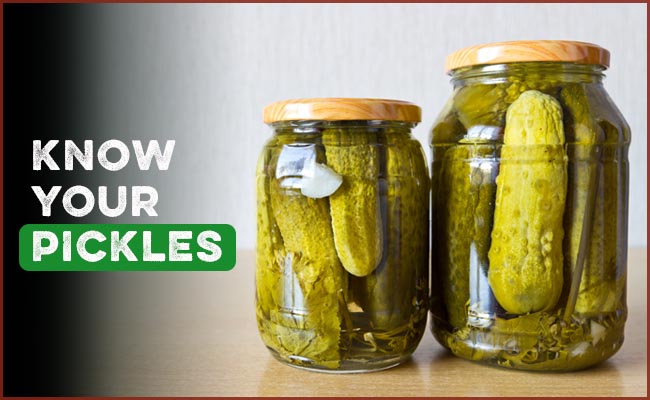
Man, I love me a good pickle.
There’s something about that salty, sour, sometimes sweet taste that really hits the spot.
Pickles are delicious on their own.
When I’m craving a late-night snack, I’ll just eat some pickles straight from the jar. They’re a satisfying food that doesn’t have a lot of calories; pickles always fit your macros, baby.
A decidedly not low-calorie twist on the stand-alone pickle snack is batter-dipped, deep-fried pickles. Have you ever had fried pickles? The best.
Pickles are also an awesome accompaniment to other foods.
All kinds of foods.
I’m always generous with my pickles on my burgers.
Our family recently discovered that pickles taste great on sloppy joes.
I’ll throw pickles on the eggs that I eat every morning.
When you go to Chick-fil-A, order the spicy chicken sandwich, well done, with extra pickles. You won’t regret it.
Man, my mouth is watering just thinking about pickles.
Despite my ardent love for pickles, I didn’t know much about them. The other day I was slapping some bread-and-butter pickles on my burger, and I thought, “What makes a bread-and-butter pickle, a bread-and-butter pickle? How is it different from a dill pickle?”
So I investigated.
Below I share my findings. After reading this article, you’ll be able to drop expert pickle knowledge bombs at your next cookout as you throw some pickles on your burger. And on everything else.
Brief History of PicklesPickling is the process of preserving food by either fermenting it with brine or submerging it in vinegar.
Pickling as a way to preserve food has been around for a long time. Mesopotamians used vinegar and brine to preserve veggies and fish way back in 2400 BC. The Chinese were using brine to preserve foods starting in 1100 BC.
While pickling has been used across time and cultures to preserve all sorts of food, these days, when someone says, “Hey, pass the pickles,” there’s a particular type of pickled food they’re referring to: pickled cucumbers.
You’ll find lots of websites claiming that pickled cucumbers have been a thing since the days of ancient Babylon and that Roman soldiers ate pickled cucumbers to give them strength. But according to a 2012 Annals of Botany paper, it’s more likely that ancient references to cucumbers were actually describing snake melons — a melon that looks and tastes like a cucumber, but is a melon nonetheless.
It wasn’t until the Middle Ages that cucumbers became the go-to pickled produce of choice in Europe. This is likely the beginning of “pickle” as a noun meaning “pickled cucumbers.” During the Renaissance and the Age of Exploration, pickled cucumbers were enjoyed by sailors, Queen Elizabeth I, and Shakespeare.
Pickles came to America with early explorers and settlers. During the late 19th and early 20th century migration of Eastern Europeans to New York City, Ashkenazi Jews brought their unique kosher pickling process to America. Kosher pickles quickly became the condiment of choice in Jewish delis, and the delicious pairing of pickles with fatty meat was born.
Two Ways to Pickle a Pickle
There are two primary ways to pickle a pickle: submerging a cucumber in vinegar and fermenting it with salt.
Vinegar Pickles
If you pick your pickles off the grocery store shelf, you’re purchasing pickles that were preserved using vinegar. The typical vinegar used for store-bought pickles is distilled white vinegar. One thing to note about vinegar pickles: they’re not fermented.
Vinegar pickles are typically pasteurized, a heating process that slightly cooks the pickles.
The upside of pasteurizing is that it kills all the bacteria in the pickles and allows a jar of unopened pickles to be stored at room temperature on a grocery store or pantry shelf for up to two years (you should refrigerate pasteurized vinegar pickles after opening the jar).
The downside is that pasteurized vinegar pickles have a lower vitamin content than unpasteurized pickles. They also have a soft, chewy texture; they’re not crisp (which may or may not be a downside, depending on your texture preference). Think of the pickles that you get on your McDonald’s cheeseburger; that’s a great example
No comments:
Post a Comment